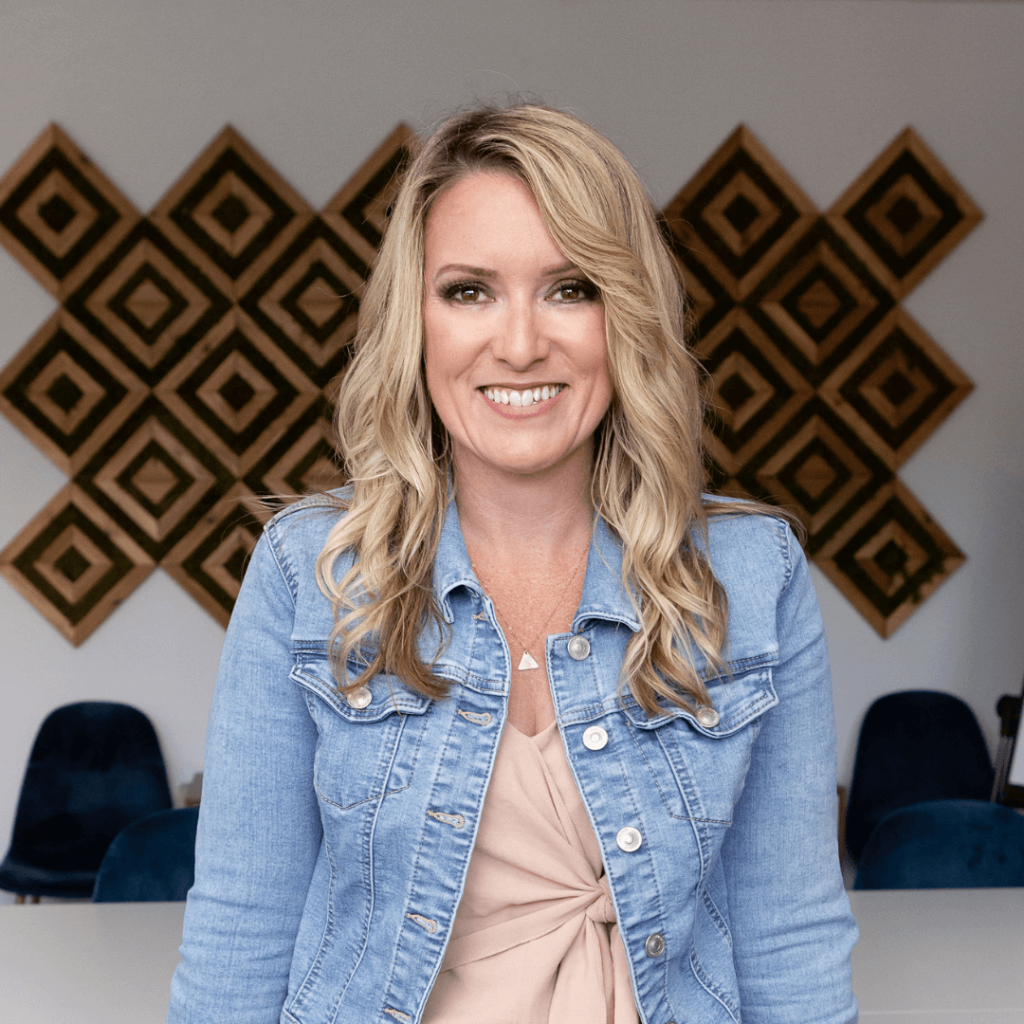
What if you could make all the money in the world…if you could just take out the emotion?
This is the question I find myself asking after interviewing today’s business case study, a long-time web designer who struggled for YEARS with client boundaries, chronic overworking and undercharging, and NOT wanting to ask for money.
Today, however, she earns $500,000 a year—and she’s finally figured out a system for herself that works. 🌟
I was really excited to do this business breakdown for several key reasons:
- Today, she’s now the QUEEN of what I’m going to call “unusually beautiful client boundaries”—and they’re 💯 responsible for her being able to make a half a million a year (you’re going to take so many notes).
- She’s a total introvert who used to hate selling herself, until she mastered the (SO SMART) sales process we’re going to talk about today.
- She totally figured out how to scale without overwhelm—she spends 5 hours a week running her core business. (Not a typo.)
- Instead of Facebook ads, she does something else—I rarely hear of this being done, but holy ukuleles, it converts like gangbusters!
- She turns away clients who are “in a desperate situation”—not because she doesn’t care, but because she DOES. However, this strategy has a massive silver lining: it ensures that all of her clients are financially stable, invested, and committed. And WHAT a difference this makes.
- She says that hiring her first employees “changed her life”—and she tells us her secret for how she hired without all the dread and fear of managing other people. (In fact, they manage her, rather than the other way around.)
- She’s an excellent example of someone running a profitable, year-round evergreen program with ease—and today’s breakdown is a MUST if you want to earn more on autopilot.
When Shannon Mattern and I get on the phone, it feels like talking to an old friend from college. Not that we are old friends from college (sadly, because we absolutely would have some good stories!) but because Shannon and I have been in each other’s orbit since circa 2014, when I had much better hair.
One of my earliest digital products, Brandgasm, was the FIRST product that Shannon affiliated for, giving her a taste of what we’ll call “passive income”—even though that term makes me a little barfy.
Back then, she was just getting started as a web designer.
Today, she earns $500,000 a year with her craft, and so I set out to answer the question all of us have on our filthy little lips: how?
”How” is one of the reasons I love this series so much. You cannot know what’s possible until you see it being done, and then once you do?! ALL the doors fling open. Like, whoa, if she can do that…maybe I can, too. If you want to talk about empowerment, you need to start with possibility.
Possibility is power.
And for Shannon, it’s been a driving factor in her own success.
But, let’s not start there. Let’s start in the place where most people start: when things suck and everything feels hard. Isn’t that a fun place to be? And yet, it’s a necessary step on EVERYONE’S journey, because unless you are a supernova from outer space, you will not have it all figured out in the beginning.
For Shannon, the thing she needed help figuring out?
How to run a business without asking for money. Like, ever.
Sounds impossible, right? But asking for money was one of her earliest emotional hang-ups. And unless you grew up negotiating yacht buy and sells for your father in the Bahamas, asking for money in exchange for your work can be HARD. So hard, in fact, that many people would rather stay broke than have to do ~the deed~.
But for Shannon, it wasn’t about self-worth as much as it was a much more practical matter: if I take your money, then I will be beholden to you in a way that overwhelms me.
Shannon had been traumatized by some clients early on in her web design freelance career, leaving her feeling apprehensive about 1:1 work in a BIG way. But as she’ll tell you now, it wasn’t actually the clients that were the problem: it was her lack of boundaries. She didn’t know how to be a “good” web designer without also being available to everyone all of the time, for whatever they needed.
She had been left feeling beholden to everyone. While her web design business was successful on the surface, she was drowning underneath. As she recounted to me:
”While I had the freedom to work from anywhere… I was ALWAYS working wherever I was because I had zero boundaries and didn’t know how to charge, manage clients, etc. I was making money, but I was basically making a little less an hour than what I made waitressing in high school…”
In order to avoid the pain of being needed too much, she started keeping herself intentionally small: on the inside, she didn’t want to grow because doing so would make her responsible for too many other people’s lives.
As soon as she says this, I recognize this as A BIG THING. I don’t think we talk about this enough, but maybe because we haven’t been conscious of it enough. Selling your services to other people can be heavy, because it is A LOT of emotional load. It’s a ton of mental weight. Combine that with unreasonable clients, and it only makes sense that we would self-sabotage.
Self-sabotage is self-preservation.
Self-sabotage means peace.
RAISE YOUR HAND if you just got a glimpse of yourself in the mirror. (?!?!)
Shannon recognized this as a problem early on: the burden of taking on so many clients at a low price point meant that she would forever be in emotional debt. God, now that I just typed it, I love that term: emotional debt. Such an accurate part of the creator experience.
As a result, Shannon made a plan.
She would start affiliating other people’s work. (That’s when they give you a link and you post about their stuff in exchange for a commission of sales that come through you.) This would mean she could sell without the burden of (a) Directly asking for money and (b) Having to fulfill on the backend.
In her words:
“I didn’t want them to pay ME directly because I didn’t want to be beholden to them (still hadn’t fixed that employee mindset and all my boundary issues) so I decided to make a free training that I’d give away in exchange for an email address and I’d recommend products + services in that training using affiliate links and make money off the back-end of the training. Then all I had to do was market a totally free training, and voila! Making money from web design without customer service OR clients.
The free training was called: The 5-Day Website Challenge, and inside, Shannon would teach you how to DIY your own website. Inside, she would show you the tools you’d need, and then link up to them with her affiliate links, enabling her to earn commission for any sales she made.
It worked.
Actually, it’s one of the components of Shannon’s business today that’s still going strong! To date, it’s helped over 25,000 people DIY their website, and brings in $100,000 a year—without Shannon doing hardly anything. The whole system is on autopilot, so as soon as you opt-in for the free training, here’s what happens:
First, you’re taken to a landing page that has a gorgeous video of Shannon, walking you through all of the Day One content. (In this case, WordPress 101.)
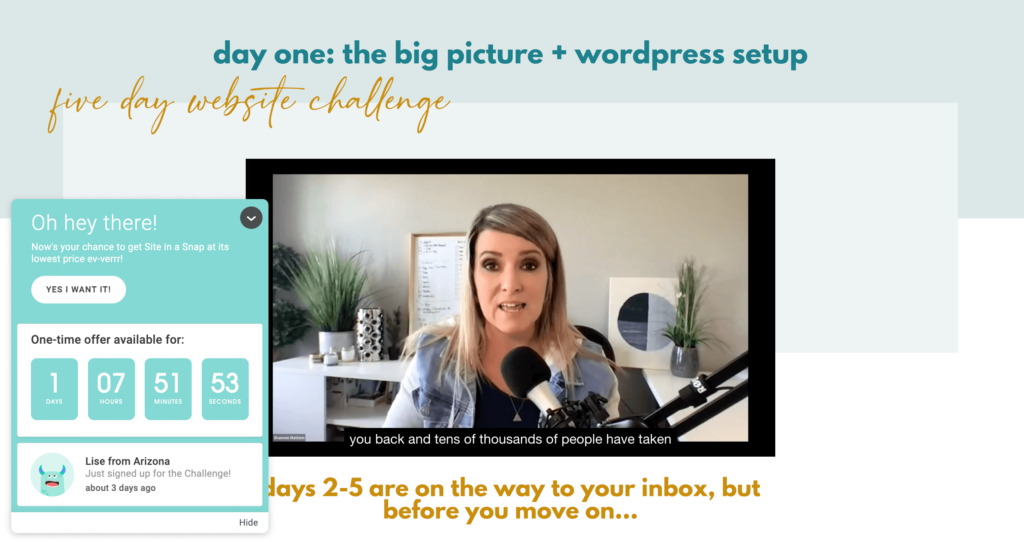
Genius Move #1: Right there on the page where she’s delivering the free content, she’s ALSO selling an upgrade below the video to her “Site in a Snap” product, which are pre-designed templates you can buy and install in order to make DIYing your site even easier. (This was an additional product of her own that she created and added later.)
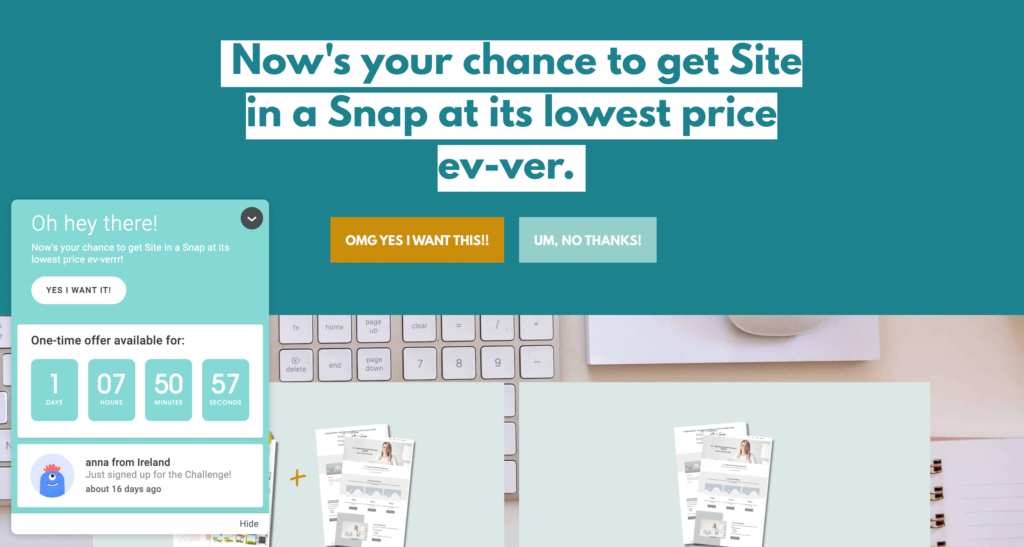
Genius Move #2: If you upgrade now while you’re on the page, you can get Site in a Snap for its lowest price ever. So, she’s making subscribers a special one-time offer to lock in a low price if they do so within 36 hours.
Genius Move #3: She uses Deadline Funnel to enforce the deadline—and also pop up this gorgeous box on the left, drawing your attention to the special offer. (I LOVE Deadline Funnel.)
Genius Move #4: She makes it ultra-obvious that you’re getting a massive discount if you upgrade now. The pricing shows a discount from $497 regularly, down to $197 if you buy today.
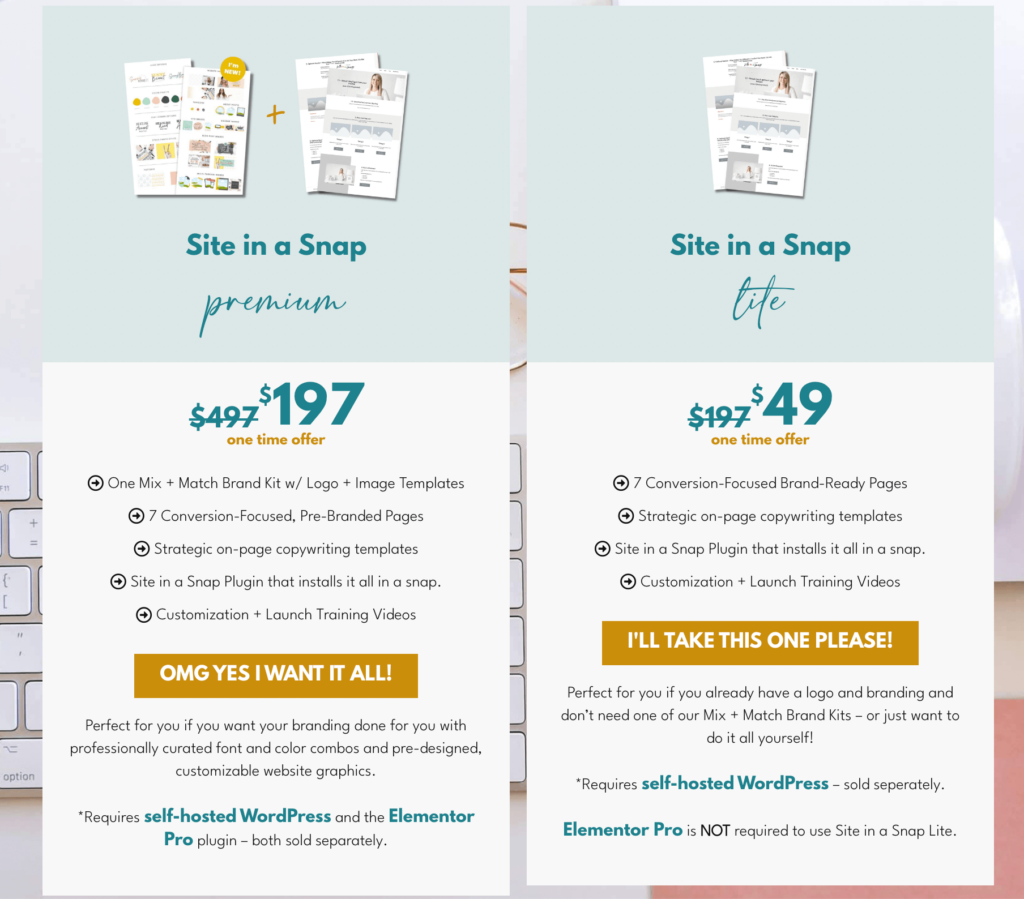
In the meantime, the free training video contains her affiliate links, and then she follows up with daily emails connected to different training videos for each of the five days.
So, this strategy actually worked and has been a pretty great success for Shannon, with minimal time needed to make it work. Once the whole system is on autopilot, she can just focus on marketing the free 5-day training.
To turn this on autopilot, she uses ConvertKit to send all of her emails on autopilot, and again, Deadline Funnel to enforce the deadline. Once the deadline is up, subscribers will be taken to an “oops, you missed it” page, where they can no longer access the special offer.
(Note: I use both of these too, religiously, for my own businesses. Gold standard right here.)
Shannon’s autopilot strategy worked—but then she faced a new problem.
Folks still wanted to work with her. But her business was only set up to help them up to a very limited point. She was leaving tons of money on the table, all because she had PTSD from her earlier client work when she was a young designer.
A business coach ended up taking Shannon’s Site in a Snap, and it resulted in the following conversation:
Business coach: “Cool! Thanks for showing me how to do this. But I don’t have time to do this. Can I hire you to do it?”
Shannon: “Nope, no way, my experience working with clients was traumatic, I don’t do 1:1 client work, you can’t hire me, thanks, bye!”
Business coach: You can make money $65 at a time with these affiliate commissions, or $197 at a time with this DIY course, OR you can streamline your web design process, start doing it THOUSANDS at a time by fixing your pricing, creating boundaries and teaching your clients how to treat you and taking control of your projects. Let me ask you a question, if your car broke down, would you just abandon it on the side of the road and get a new car? No, you wouldn’t, because it’s still valuable, it just needs to be repaired. What you’re doing by abandoning your web design business is basically leaving your car on the side of the road. Once you fix your broken web design business so that it starts making money for you in a way that’s sustainable, you can teach other web designers how to do it because I can promise you, you’re not the only one struggling.
It made Shannon think.
She started working with the coach, and taking on clients again. She worked with the coach on boundaries, on mindset, on packages, on pricing. She hired a systems expert to help her map out the entire project management process and map out all the places where it could break down and create solutions ahead of time. Yet, she was STILL way undercharging, despite her coach’s pleas to charge more, because her money mindset was still super messed up.
She got to the point where half of her income was coming from her 5-Day Challenge, and the other half of her income was coming from her client work—in a way that felt sustainable.
FINALLY she was making progress.
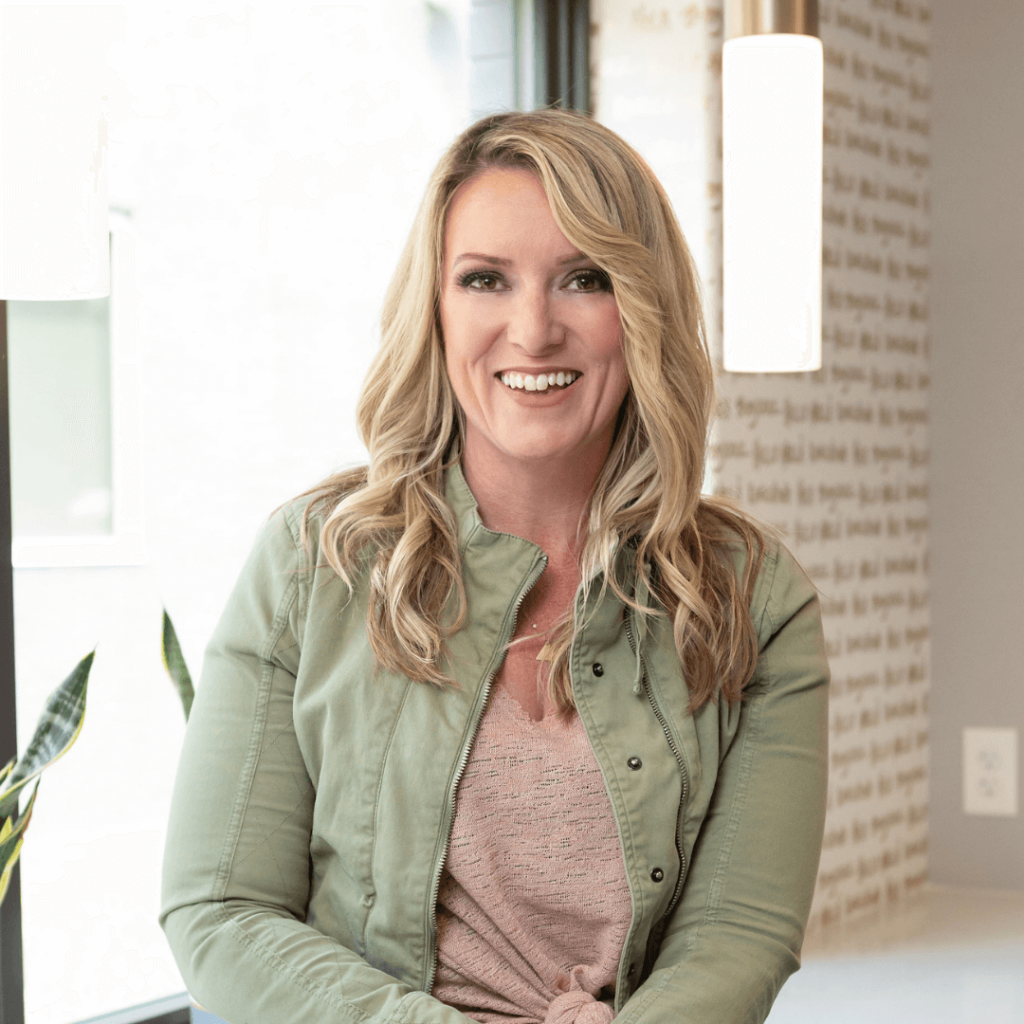
Then one day, she got an invite from Skillcrush, who teaches women coding and WordPress dev, to speak at a virtual conference they were hosting all about making money with web design.
She accepted!
That’s when her business coach said this: “You need to put together a coaching program for web designers to teach them everything you’ve learned about running a web design business, and you need to create a webinar that you’ll invite these people who watch your Skillcrush presentation to, and just make the offer for the coaching program. You’ve got nothing to lose and everything to gain.”
She DID IT.
She had 600 people opt in for her webinar.
This became what is now Shannon’s Profitable Pricing Framework for Web Designers. 🌟 (You can opt in and see what it’s like!)
From there, she took her coach’s advice and then made a simple offer to all attendees to join her in what is now The Web Designer Academy.
She got 6 students her very first time.
She was only charging $600.
It earned her $3,600, giving her the seed money to build a fully fleshed out program.
Now that she was in a room with six other web designers, she realized how far she had come: they were suffering from all of the same things she had in the beginning. Many of them were on the verge of quitting. They were burnt out and overwhelmed. And Shannon was able to teach them everything that SHE had to learn the hard way.
The program was a success.
So much so, that she decided to run another round.
She realized she enjoyed working with web designers even more than she liked working with website DIYers.
Beyond that, there was a ton of backend support required for her DIY templates, Site in a Snap, since customers would often write in needing tech support.
So she kept leaning toward selling her intellectual property. I talk all the time about the value of this—it’s a GAME CHANGER for your business. And that’s exactly what you’re doing when you document your methods, your processes, and the things that have worked for you, and turn them into a program you can sell: you’re taking your knowledge and turning it into bonafide intellectual property.
Fast forward to present day, and now? Shannon’s phasing out the DIY side of her business, and going full-steam on teaching web designers how to run a profitable business.
Except today, a lot has changed: she now charges $7,500 today for the Web Design Academy, and now $400,000 of her profit is coming from that for a grand total of $500,000 a year. And she’s only going to keep growing!
So let’s unpack how her business works!
One: Shannon markets her business in two main ways: by speaking at virtual conferences and going on other people’s podcasts—and then drives people to her free training.
Here’s how she explained how it works over the phone:
I do a lot of summit presentations or sponsorships. I always do a live training off the backend of that. “Oh, hey, apply for this live training.” I’ll have a bonus incentive for them to join now. For example, I recently sponsored the Simply Profitable Designer Summit. I had 250 applications, 30 new students join. All I had to do was pay $5K to sponsor it and speak. Why am I gonna give Facebook $5k?? I can’t with that. I’d rather give it to someone running a summit full of my ideal client who are there to learn. I DID run FB ads for a time last year, and they were profitable on paper, but I have people making payment plans. So, return on ad spend over time was profitable, but outgo every month wasn’t enough bc they were payment plans. I like to run a debt-free business.”
That’s important to note: if you have payment plans, you might not be able to afford to run ads the same way you would if you had pay-in-full options, because you aren’t getting all of the cash flow up front.
When I asked her what the ratio was of people who pay in full versus payment plan, she said that for every five customers, one will pay in full, and four will choose the payment plan. So as you can see, having a payment plan is an important business strategy. BUT, you also have to be thoughtful about how much money you’re spending in order to get those clients, because you’ll have to front load a lot more money in ad spend while you wait for those payment plan payments to come through over time.
More importantly, however, Shannon’s had FAR better conversions simply by finding her actual target market at conferences made especially for them, rather than “paying and spraying.” She swears by this method. And if you do the math?
- She spent $5K to sponsor a summit and speak (this is typically when they’ll let you promote your stuff, too)
- She had 30 new students join
- At $7,500 each, that’s $225,000 in revenue earned
- For a grand total of $220,000 in profit
Which is all to say: spending $5K to speak somewhere might seem like a lot, until you realize the potential upside. Of course, you’ll have to have the right systems in place, so let’s keep going.
Two: She then invites you to apply for a free advanced training.
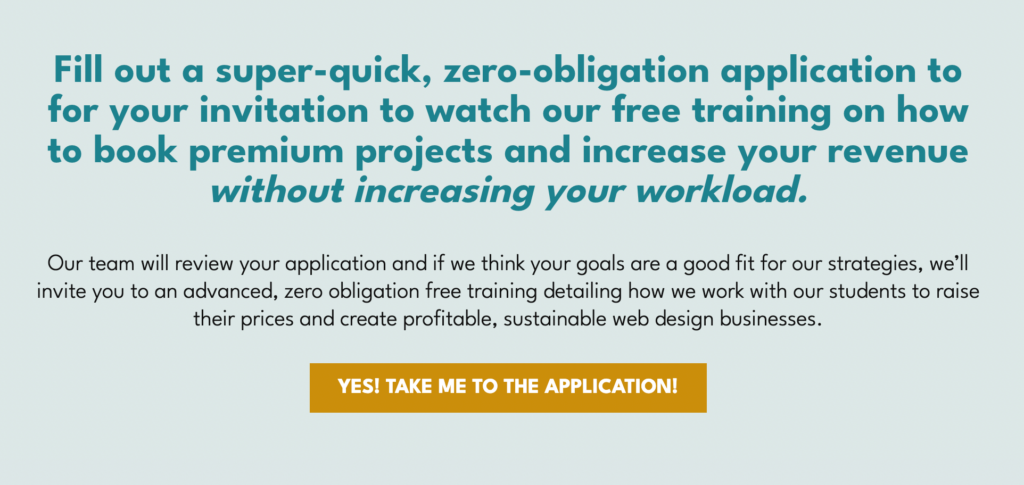
This is WILDLY different from what you’re used to (Shannon credits Mariah Coz, one of her mentors, for this genius system). Most people would just tell you to go sign up for the free training and then cross their fingers that you actually do, but Shannon’s figured out that if you invite people to apply for your free training right then and there, while also offering a bonus incentive, it makes people act. Plus, it also feels more exclusive. And then Shannon can individually vet each client, opening up direct communication with the people who do apply, greatly raising her conversion rates.
She told me that this is currently converting at 30%—meaning that 30% of the people who see it, will apply.
You can see how this works here.
That’s the evergreen version, so you’ll see the free training at the top, followed by the “invite to apply for the advanced training.” THIS IS GENIUS. What she’s doing here is qualifying prospects by making you go through a series of steps to actually enroll in the final goal: The Web Designer Academy.
It might be tempted to assume that more steps = less conversions, and that’s true with low-priced digital products, but for high-ticket products? More steps = more commitment. And the people who make it through are going to say YES.
Three: Once you apply to receive the advanced training, Shannon will personally stalk them online. 😀
She says this will be her next hire, but for the meantime, she individually vets every single applicant. The main thing she looks at is their goals. I asked her when she would turn someone away, and here’s what she said:
A common reason we turn people away is if they want to LEARN web design. You have to come here with the skills and we’ll teach you how to run a business. Or, if they’re really, really beginner or just getting started. We CAN help them, but they have to have the runway to ramp up. Or if they’re desperate, everything’s falling apart, and “I just need clients”…this isn’t right for you. This will actually make your situation worse. This isn’t what you need right now. Go reach out to all your contacts and let them know you have a spot. Or, you get people who think your application who think it’s an automated form and put blanks (those are automated kick outs).
I thought this was incredibly well thought out—and it’s one of the reasons why she really enjoys her business today. One of the things she emphasized was the importance of having not just any clients, but the right clients. And, she’s done a great job in putting in the filters to make sure that she’s going to be able to help them…and they’re going to be able to help themselves.
We talked about THIS at length, and omg. It all circles back around to having healthy client boundaries. This gem that Shannon dropped right here is going to change your life. ⬇️
People think just like I used to: “Oh, the more i charge, and the longer I allow people access to me, the more they’ll need from me, and I can’t, I dont’ have the emotional bandwidth to be beholden or responsible for these people – I just can’t handle what everybody needs from me. If my price is low, then they can’t ask that much from me.” But no – your price gets to be high, you get to point the responsibility where it lies, which is on your clients, to use the thing you’ve created for them or be active in the process of creating; to be responsible for their own outcome and results. You’re responsible for creating the tools. You get to charge well for that and create boundaries around that. We can’t create a situation where we’re disempowering them or take over their business or letting them fall into patterns of “Oh, I didn’t have time to participate in your program, so I should get X,Y,Z.” I’m holding your boundaries. I’m holding this boundary for your own good.
Four: She’ll make qualified applicants a quick video.
Here’s what the video says: “Hey, I loved your application – here are the opportunities I see for your goals and what our program can do. You’re invited to watch a webinar to hear about our frameworks and how we work and hear from some of our students.”
THEN they watch a webinar that’s a harder sell than the first one. 💛
And because people had to apply for it, they’re going to watch it, because now there’s a much greater perceived value, right?
This strategy is 💯 one to steal!
She’ll also follow up with them personally to see if they are going to join them, so in reality, she’s doing a sales role.
On a heavy day, she says, she’ll spend one hour doing this. But, she also has help from her ops manager. Here’s their system:
New applications go into AirTable. Ops manager prepares the response. I make the video, pop it in the email, send it off. Heavy day = one hour doing those.
Shannon told me that 25% of applicants convert into actual customers.
Five: Once you’re accepted into The Academy, the program begins!
All of this is on rolling evergreen, right? Meaning that someone can join anytime since Shannon has these systems set up.
Once that happens, there are three parts to the program:
- A year-long curriculum that teaches you how to run your web design business.
- Weekly coaching from Shannon.
- Weekly work reviews from Shannon and her team.
This is where things get really good.
- The curriculum is already pre-recorded, so Shannon doesn’t have to keep repeating herself over and over again: new customers can get in and get started right away.
- If they have questions, they can pre-submit them anytime, and Shannon will answer them on her weekly coaching call every Tuesday. THIS IS BIG. It helps you support many people all at once, because everyone’s question is helping another person who probably had the same one. THIS IS WAY MORE REVOLUTIONARY THAN YOU MAY RECOGNIZE. First of all, because this is an excellent way of managing the flow. Normal businesses might have customers asking questions all the time, but by putting a boundary around when you answer questions, you simplify everything. Now you’re not running around like a chicken with your head cut off, just trying to keep up with email, but you’ve created a special space for questions each week. Secondly, because people are often nervous to ask things on live calls, this ensures that everyone gets their questions answered. Especially important if they aren’t able to attend live. LOVE. Thirdly, you’re always going to get customers who write in to your inbox privately and say, “Oh, I didn’t want to ask it on the call but….” This can be tricky for business owners because that starts getting into private consulting land, rather than group coaching. It’s also not fair to other customers who don’t have that private access. So in order to manage this expectation, here’s what Shannon says: “Great, we’ll add that to our queue for this Tuesday’s call. Your question is a gift to everyone else who is too scared to ask. Everyone else who is too scared will thank you.” How brilliant is that???
- Once they’re on the live coaching call, Shannon will ask folks to tell her what their wins have been that week, and it kicks off a flurry of what are essentially testimonials. They’ll screenshot all of that awesome social proof, and use it in their marketing! (What a GREAT way to get testimonials.)
- Finally, the program also offers weekly work reviews—so there is a more hands on component, but it’s also tightly managed. Rather than inviting customers to send in their stuff anytime for review, Shannon’s system is this: once a week, you can submit something for feedback (a sales page, your packaging, your pricing, etc.). You do that via a designated form. Every Thursday, her and her team will review. (She says they spend 2-3 hours doing this.) Then, her client success coach, Erica, will record a Loom video sending the customer back their collective feedback. This keeps Shannon out of the weeds, while still offering valuable feedback in a quick and actionable way. Then, they upload it all into Access Ally, where customers can log in anytime into a customer portal to see all of their feedback. (LOVE.)
The above system is EXCELLENT, and really speaks to the power of having a team—or, at least a few select members who can streamline your operations so you aren’t spending your every waking hour supporting the whole thing.
In fact, Shannon loves her team so much that she said this about hiring:
”LIFE CHANGING. WORTH EVERY PENNY. I realized that if I’m the only one doing this, I’m the biggest risk to my business. So when I shifted from working with contractors to hiring full-time employees, my whole life changed. Now, their only job is to work with me. They’re all in on our mission. I had to make a bigger commitment to them, and I’m paying them real salaries. But their commitment is just as big to me and and to our mission, and it’s a whole thing, and it’s beautiful and magical, and I love it.”
Shannon worked with Paradigm Consulting to figure out how to actually bring on employees and do it all in a way that worked for her.
”I left a corporate job that I hated, and I did not want to recreate the environment that I had in corporate with my employees. So I hired a firm called Paradigm Consulting. They help me. I’m like, I don’t want to track time. I don’t want my employees to have to ask for permission to do life. How can I create policies and procedures and things that support them the way I wish I would have been treated when I was an employee? So now, I have one meeting a week with my employees for thirty minutes. Everything else is done asynchronously. It’s like: I don’t need you to be working when I’m working. I don’t want to be working when you’re working. So you have to be a grown up. I’m paying for people that are that caliber of person.”
How brilliant.
Her two main employees are:
- An Operations + Marketing Coordinator who plans out their calendar, manages launches and promotions, handles the inbox, and does backend support.
- Her Client Success Coach, who helps support their customers in the ways I outlined above, mainly with weekly feedback.
Right now, her system is a dream—and it all started with seeing the possibility, and then just taking the action necessary to make it happen without overthinking it, or getting stuck thinking about all the things that could go wrong. Instead, she thinks most about how to make everything go right.
They’re doing so well, they’re anticipating raising their price to the program from $7,500 to $10,000+ in the near future.
And get this????
She’s done ALL of this with an email list of just 2,500 web designers. 😲 This is even further testament to the idea that size doesn’t matter as much as RIGHT. You get the right people in the room, you can do well. Get the wrong people in the room, and it won’t matter if there’s a million of ‘em.
And whether you’ve got 5 clients or 500, there are ways to do it so you don’t put yourself in a position of overwhelm: this was one of Shannon’s greatest lessons.
When you put out “unusually beautiful boundaries,” you get unusually beautiful results.
But it starts with knowing how you want to work, and how you work best, and then designing a business that actually works with YOU, rather than trying to beat yourself into submission to work within IT.
You will have to ask people for money, but when you do it right?
They’ll be happy to give it to you.
And you’ll be happy they did, too.